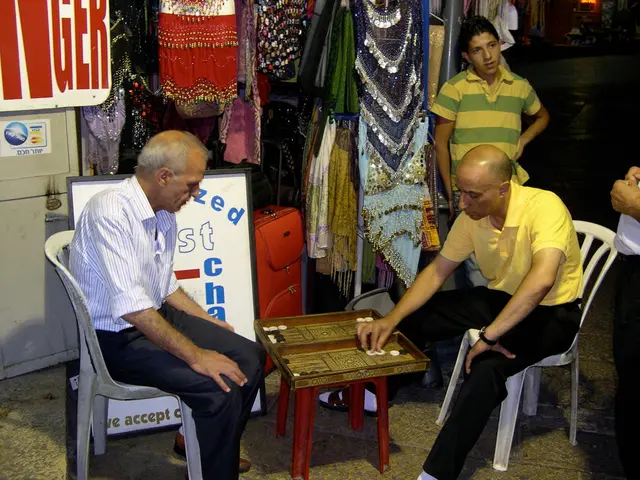A Century Ago: Anniversary of the Polish Zloty
Droppin' Knowledge: A Peeve-Free Tour Through Poland's Iconic Zloty
Mark your calendars for 2024! That's when Poland turns 100 with the zloty, a resilient currency that's survived through thick and thin. From political tumults to economic shifts, this bad boy has seen it all and continues to symbolize Poland's pride and independence. So buckle up, dear reader, as we dive in to discover the zloty's backstory, its evolution over the past century, and its significant impact on modern Poland.
After Poland regained its independence in 1918, the nation was drowning in a sea of currencies, hyperinflation, and economic chaos. The arrival of the zloty in 1924 aimed to bring order to the chaos, unifying the economy under a single currency. The name "zloty," meaning "golden" in Polish, was a nod to the historical currency used during the Kingdom of Poland's golden age. This historical connection was designed to instill a sense of pride and continuity among the populace.
Artsy-Fartsy Banknotes
The initial designs of the zloty notes were the products of prominent Polish artists, who were tasked with creating a currency that oozed national pride, heritage, and sovereignty. These early banknotes were embellished with stunning images of Polish kings, national heroes, and iconic landmarks, making them double as symbols of Poland's rich history and culture. And let's not forget about the top-notch security features, like watermarks, complex engravings, and specialized color palettes – fancy stuff for the era, mate.
Zloty's Journey Through Wars and Economical Times
The saga of the zloty is as thrilling as a rollercoaster ride, with twists and turns that mirror Poland's tumultuous 20th century. During World War II, the zloty remained in circulation, albeit under strict regulations imposed by occupying forces. Post-war saw the re-emergence of the zloty, but this time under the communist regime, which pegged the currency to the Soviet ruble and isolated it from global markets.
The fall of communism in 1989 ushered in a new era for the zloty. The transition to a market economy demanded a radical overhaul of Poland's financial system, including a significant redenomination of the zloty in 1995. This monumental move symbolized Poland's break from its communist past and its steps towards integrating with the global economy. The zloty was pegged to a basket of currencies initially and later allowed to float freely, marking the beginning of modern financial policies in Poland.
Euro: Worth the Trouble?
As Poland headed into the 21st century, the debate over adopting the Euro heated up. The pros argued that joining the Eurozone would mark Poland's full entry into the European core, while the cons contended that maintaining the zloty allowed for greater control over monetary policy during global economic crises like that of 2008. As of now, Poland remains zloty-loyal, and the zloty continues to stand as a symbol of national pride and economic independence.
In 2024, Poland celebrates the zloty's 100th birthday with a bang, issuing commemorative coins and banknotes to honor the zloty's journey. These collectibles are sure to feature designs that reflect Poland's economic milestones and the iconic figures who've shaped its history, like, say, jousting kings who'd give that bloody dragon a run for its money.
There you have it, mate! The zloty: a tale of resilience, adaptability, and cultural pride that's as much a part of Poland's history as a bowl of borscht or a round of vodka. As we toast to the zloty's centennial, let's raise our glasses to the many more years of good times, stable economies, and Vodka pass-outs it'll bring to this glorious nation we call Poland.
Cheers!
Want to stay updated with news from Poland? Sign up to receive a weekly recap of news every Saturday – we promise you we don't spam! Confirm your subscription by checking your inbox or spam folder. It's all good, mate!
- The year 2024 marks a milestone as Poland celebrates the 100th anniversary of the zloty, a currency that has endured political tumults, economic shifts, and wars.
- In 1924, the arrival of the zloty was aimed at restoring order and unity to Poland's chaotic economy, which was facing hyperinflation and a clash of currencies.
- The zloty's name, meaning "golden" in Polish, served as a symbol of the historical currency used during the Kingdom of Poland's golden age, instilling pride and a sense of continuity.
- Early zloty banknotes were designed by Polish artists, featuring representations of Polish kings, national heroes, and iconic landmarks, making them symbols of the country's rich history and culture.
- The saga of the zloty is as dynamic as Poland's 20th-century history, with the currency surviving under various governments, including occupation forces during World War II.
- After Poland's transition to a market economy in 1989, the zloty underwent a redenomination in 1995, symbolizing a break from the communist past and the start of a new era in global market integration.
- The ongoing debate over adopting the Euro and maintaining the zloty has highlighted the tension between European union and national economic autonomy, with Poland choosing to stay with the zloty for the time being.
- In 2024, commemorative coins and banknotes will be issued to honor the zloty's centennial, showcasing Poland's economic milestones and historical figures who have shaped the nation's destiny.









